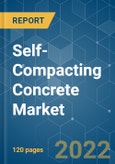The market for self-compacting concrete is expected to grow at a CAGR of about 6% globally during the forecast period. Growing demand from the residential sector along with increasing infrastructure activities & construction of complex and high-rise structures and reduces labor costs and eliminates the use of vibration processes are driving the market. On the flip side, higher raw material costs coupled with unfavorable conditions arising due to the COVID-19 outbreak are hindering the market growth.
Key Highlights
- The self-compacting concrete market is expected to grow during the forecast period owing to the growing demand from the residential sector.
- Asia-Pacific region to dominate the market across the globe with the largest consumption from countries such as China and India.
Key Market Trends
Growing Demand form the Residential Sector
- Self-Compacting concrete is widely used in construction applications and is expected to be the fastest-growing segment due to growing construction activities during the forecast period.
- Self-compacting concrete does not require any vibration to be placed and compacted. It compacts and gets placed based on its weight and offers superior properties than vibrated concrete.
- The advantages of using self-compacting concrete are that it reduces labor and equipment costs along with that it increases ease of construction as well as the quality, durability, and reliability. The use of self-compacting concrete reduces the construction tie as well as permeability. The noise from the use of vibrator equipment is reduced thereby eliminating the hand-arm vibration syndrome and hearing damage.
- According to the European government, it is facing a housing shortage with the need for additional housing which is estimated at 2.3 to 3 lakh new units per year. So, the government plans to deliver 4 lakh new housing units by 2021, of which 1 lakh units are to be financed with EUR 2.7 billion through a new Housing Infrastructure Fund. The European government is likely to finance investments of about EUR 26.8 billion in infrastructure, housing, and research & development for the year 2017-22 through National Productivity Investment Fund.
- The United States residential sector spending is valued at around USD 6.2 billion in the year 2019. The construction industry in the United States continued to expand in the future, owing to a strong economy and positive market fundamentals for commercial real estate, along with an increase in federal and state funding for public works and institutional buildings. With the growing population the rise in spending for the construction of residential buildings such as apartments, individual houses, duplexes, etc., is expected to drive the market for self-compacting concrete during the forecast period.
- The growing need for infrastructure and sustainable development in emerging economies is expected to drive the market for self-compacting concrete during the forecast period.
Asia-Pacific Region to Dominate the Market
- The Asia-Pacific region is expected to dominate the market for the self-compacting concrete market during the forecast period due to an increase in demand for construction activities from countries like China and India.
- The Indian government has allocated USD 63 billion for the infrastructure sector in 2019-20 and is planning to spend USD 1.4 trillion over the next five years. Furthermore, the construction industry in India has received a major boost by the investment of USD 1.4 billion through private equity and venture capital investments during October 2019.
- Moreover, according to the National Development and Reform Commission of China, the Chinese government approved 26 infrastructure projects at an estimated investment of about USD 142 billion in 2019 which are expected to be completed by 2023.
- China has always reacted to the economic slowdown by providing stimulus through monetary policy and by increasing infrastructure investments. Post COVID-19, the Chinese government is expected to do the same to get the economy back on track by increasing investments in the construction sector, particularly infrastructure.
- The aforementioned factors, coupled with government support, are contributing to the increasing demand for the self-compacting concrete market in the Asia-Pacific during the forecast period.
Competitive Landscape
The global self-compacting concrete market is partially fragmented with players accounting for a marginal share of the market. Few companies include CEMEX S.A.B. de C.V., Sika Limited, LafargeHolcim, BASF Group, and Roadstone Ltd.
Additional Benefits:
- The market estimate (ME) sheet in Excel format
- 3 months of analyst support
This product will be delivered within 2 business days.
Table of Contents
Companies Mentioned (Partial List)
A selection of companies mentioned in this report includes, but is not limited to:
- BASF Group
- Breedon Group plc
- CEMEX S.A.B. de C.V.
- Firth
- HEIDELBERGCEMENT AG
- Instarmac
- LafargeHolcim
- Roadstone Ltd
- Sika Limited
- Tarmac
- Ultratech Concrete
Methodology

LOADING...








